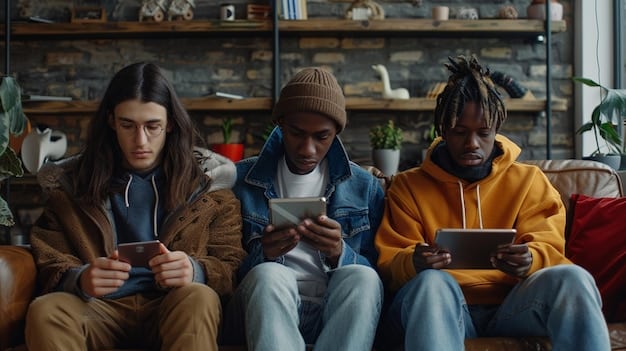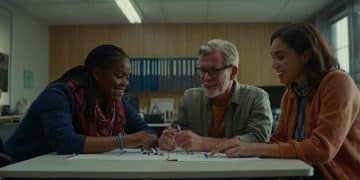Inclusive Image Descriptions: Alt-Text Best Practices 2025

This comprehensive guide delves into The Ultimate Guide to Inclusive Image Descriptions: Alt-Text Best Practices for 2025, offering an in-depth exploration of how to craft effective, empathetic, and SEO-friendly alt-text that significantly enhances web accessibility and user experience.
In the evolving digital landscape, where visual content dominates, the importance of making this content accessible to all users cannot be overstated. This is where The Ultimate Guide to Inclusive Image Descriptions: Alt-Text Best Practices for 2025 becomes not just a recommendation, but a critical imperative for web developers, content creators, and marketers alike.
Understanding the Evolving Landscape of Digital Accessibility
The digital world is constantly changing, with new technologies and user expectations emerging every day. In this dynamic environment, digital accessibility—the practice of designing and developing websites, tools, and technologies so that people with disabilities can use them—is no longer merely a niche concern but a fundamental aspect of good design and ethical communication. As we move into 2025, the standards and practices around accessibility are becoming more refined and integrated into mainstream development workflows, reflecting a growing societal understanding of inclusivity.
This shift is driven by a combination of factors: evolving legal requirements, a stronger ethical commitment to equal access, and the recognition that an accessible web benefits everyone, not just those with disabilities. Clear, concise, and contextually rich image descriptions are a cornerstone of this accessible web. They serve as a crucial bridge for users who cannot see visual content, transforming images from potential barriers into valuable sources of information. This includes individuals who are blind or have low vision, those with cognitive disabilities who benefit from clear explanations, and even users in low-bandwidth environments where images might not load.
The Foundational Role of Alt-Text
At its core, alt-text (alternative text) is a written description of an image that is read aloud by screen readers and displayed in browsers when an image fails to load. Its primary purpose is to convey the meaning and context of the image to users who cannot see it. However, its utility extends beyond traditional accessibility scenarios. Search engine optimization (SEO) also leverages alt-text to understand image content, contributing to better search rankings. It’s a powerful, yet often underutilized, tool.
Effective alt-text is a blend of artistry and precision. It requires careful consideration of what information is most salient in an image and how that information can be conveyed succinctly and accurately. This isn’t about rote description; it’s about translating meaning. For example, a picture of a dog might be described simply as “a dog,” but if the dog is a therapy animal comforting a child in a hospital, the alt-text should reflect that specific, meaningful context. This thoughtful approach ensures that all users receive the full narrative experience intended by the content creator.
Beyond Compliance: The Human Element of Accessibility
While compliance with standards like WCAG (Web Content Accessibility Guidelines) is essential, true digital accessibility goes beyond mere checklist adherence. It involves embedding an empathetic understanding of varied user needs into every stage of content creation and web development. For image descriptions, this means moving beyond descriptions that are technically correct but lacking in human insight. It means considering the emotional impact of an image, its subtle nuances, and how its visual information contributes to the overall message of the content.
This human-centered approach encourages creators to ask: What would a person who cannot see this image gain by understanding its content? Is there any information conveyed visually that would be lost without a detailed description? By adopting this perspective, content creators can elevate their alt-text from basic labels to rich, informative descriptions that genuinely enhance the user experience for everyone. This proactive and empathic stance ensures that inclusive design becomes a natural extension of creative expression, making the digital world a more welcoming place for all.
Crafting Powerful Alt-Text: Principles for Clarity and Context
The effectiveness of alt-text hinges on two core principles: clarity and context. A clear alt-text is easy to understand, free of jargon, and directly describes the visual information presented. Contextual alt-text, on the other hand, ensures that the description is relevant to the surrounding content, adding meaningful information rather than just a standalone observation. Balancing these two elements is key to creating alt-text that genuinely enhances accessibility and user understanding.
When drafting alt-text, it is helpful to imagine you are describing the image to someone over the phone, who cannot see it. What details are crucial for them to grasp the image’s role and message within the article? This exercise helps distill the essential elements and avoid extraneous detail, focusing on what truly matters for comprehension. Prioritizing impact over mere enumeration of visible objects leads to more powerful and useful descriptions.
Understanding User Needs and Intent
Different types of images serve different purposes, and effective alt-text recognizes this. A decorative image, for example, might have null alt-text (`alt=””`) because it conveys no essential information. In contrast, an image that is part of an infographic or a complex chart requires a much more detailed description, often pointing to the data or trends it represents. The intent of the image within the content is a primary driver of how its alt-text should be structured.
Consider the user’s journey: Are they looking for information? Are they seeking an emotional connection? The alt-text should align with these potential intents. For a product image on an e-commerce site, the alt-text should convey product details relevant to a purchasing decision. For an image supporting a news story, it should describe the scene or event depicted, adding credibility and understanding. This user-centric approach ensures that the alt-text fulfills its purpose effectively.
Key Principles for Effective Alt-Text:
- Be Concise but Descriptive: Aim for under 125 characters if possible, but provide enough detail to convey the image’s meaning.
- Avoid Redundancy: Do not start with “image of” or “picture of” – screen readers announce this automatically.
- Context is King: Describe what is happening in the image and why it is relevant to the surrounding text.
- Be Specific: Instead of “a flower,” say “a vibrant red rose in full bloom.”
- Handle Complex Images Appropriately: For graphs or charts, provide a summary of the data conveyed visually and consider linking to a more detailed description or data table.
These principles serve as a guide, but flexibility is also important. The goal is always to provide an equivalent experience for users who cannot access the visual content, ensuring they receive the full scope of information and context. This dedication to clear and contextual descriptions elevates the overall quality of web content.
The Technical Side: Implementing Alt-Text for Maximum Impact
While the art of crafting compelling alt-text lies in its content, the technical implementation ensures it reaches the intended audience effectively. Proper HTML structure and adherence to web standards are crucial for screen readers and search engines to interpret and utilize alt-text correctly. This technical precision amplifies the accessibility and SEO benefits of well-written descriptions, making them truly impactful.
The primary mechanism for delivering alt-text is the `alt` attribute within the `` tag in HTML. Its correct application is non-negotiable for web accessibility. Neglecting this attribute, or populating it with irrelevant or missing information, can severely hinder the experience for users relying on assistive technologies. Understanding where and how to integrate alt-text seamlessly into web development workflows is therefore as important as knowing what to write.
Semantic HTML and Image Descriptions
Beyond the basic `alt` attribute, consider the broader context of semantic HTML. A well-structured webpage, using appropriate HTML tags for headings, paragraphs, and lists, naturally improves accessibility. For images, this extends to using elements like `
It’s also important to differentiate between `alt` text and `title` attributes. The `title` attribute often provides supplemental information that appears as a tooltip on hover, but it is not consistently read by screen readers and should not be used as a substitute for `alt` text. The `alt` attribute is specifically designed for accessibility and is the fundamental element for conveying image meaning to users who cannot see.
Tools and Techniques for Implementation:
- Content Management Systems (CMS): Most modern CMS platforms (like WordPress, Drupal, Joomla) provide dedicated fields for alt-text when uploading images. Use these fields consistently.
- Automated Accessibility Checkers: Tools like Lighthouse (built into Chrome DevTools), axe, or WAVE can help identify missing alt-text or flag potential issues, though human review is always necessary. They can detect if an alt attribute is present, but not necessarily its quality.
- Developer Habits: Integrate alt-text creation into the regular development workflow. It should not be an afterthought but an integral part of adding any visual content to a page.
- Image Optimization: Ensure images are properly sized and compressed. While not directly alt-text, good image optimization practices improve page load times, which is a factor in overall user experience and SEO, especially for those with slower internet connections.
Proper technical implementation ensures that your carefully crafted alt-text functions as intended, providing an equivalent experience for all users and contributing positively to search engine rankings. It’s the silent work that makes loud accessibility statements.

Inclusive Language and Empathy in Image Descriptions
The language used in alt-text profoundly impacts its inclusivity. Moving beyond objective factual descriptions, inclusive alt-text embraces empathetic language, recognizes diverse perspectives, and avoids biases. This approach ensures that image descriptions resonate with a broader audience and foster a more welcoming digital environment. It acknowledges that words carry power and can either include or exclude.
Inclusive language in alt-text means being mindful of terminology, avoiding assumptions, and representing the diversity of human experience where relevant. For instance, if an image features individuals, consider if their gender, race, or other characteristics are pertinent to the image’s meaning. If they are, describe them respectfully and without stereotypes. If not, focus on their actions or roles within the image. The goal is to convey information empathetically, without inadvertently marginalizing any group.
Avoiding Bias and Stereotypes
Unconscious biases can inadvertently creep into image descriptions, reinforcing stereotypes or making assumptions about the individuals or scenarios depicted. To combat this, content creators should actively review their alt-text for any language that might generalize or misrepresent. For example, describing someone’s appearance only if it is relevant to the image’s purpose, and doing so with neutral, respectful terms.
This critical self-assessment is part of a continuous learning process. It involves challenging one’s own perspectives and seeking feedback from diverse audiences where possible. The aim is to create descriptions that are not only accurate but also considerate and empowering for all users, reflecting a genuine commitment to inclusion.
Checklist for Inclusive Alt-Text Language:
- Neutral and Respectful: Use respectful and neutral terminology when describing people, objects, or situations.
- Contextual Relevance: Only include details about identity (e.g., race, gender, disability) if they are directly relevant to the narrative or meaning of the image.
- Person-First Language: If describing a person with a disability, use person-first language (e.g., “a person using a wheelchair” instead of “a wheelchair-bound person”).
- Avoid Jargon and Colloquialisms: Ensure descriptions are universally understandable, avoiding terms that might be culturally specific or technical unless absolutely necessary and explained.
- Focus on Action and Role: Emphasize what people are doing or their role in a scene, rather than solely focusing on appearance.
By consciously applying these guidelines, writers can craft alt-text that is not only informative but also genuinely inclusive, contributing to a more equitable and accessible digital landscape for everyone. It reflects a deeper understanding of human diversity and dignity.
Alt-Text and SEO: A Symbiotic Relationship in 2025
In 2025, the synergy between alt-text and Search Engine Optimization (SEO) is stronger than ever. While alt-text’s primary function is accessibility, search engines like Google increasingly leverage this information to understand image content, context, and relevance, contributing to improved search rankings. This creates a symbiotic relationship where well-crafted alt-text not only benefits users but also enhances a website’s visibility and organic traffic.
Search engines use alt-text to categorize images, display them in image search results, and understand the overall theme of a webpage. When alt-text accurately describes an image and incorporates relevant keywords naturally, it signals to search engines that the content is comprehensive and valuable. This dual-purpose utility makes alt-text a powerful, yet often overlooked, component of a holistic SEO strategy.
Keyword Integration for Visibility
While keyword stuffing in alt-text should be strictly avoided (as it leads to a poor user experience for screen reader users and can be penalized by search engines), the strategic inclusion of relevant keywords can yield significant SEO benefits. The key is to integrate keywords naturally and contextually, ensuring they enhance the description rather than detract from it. Think about the terms users might search for if they were looking for the visual information presented in the image.
For example, if an image shows “a chef preparing a gourmet meal,” and the article is about “healthy keto recipes,” incorporating “keto meal preparation” might be appropriate if it accurately reflects the image content. The aim is always to prioritize the user experience for screen reader users first, knowing that good SEO follows naturally from high-quality, valuable content.
Best Practices for SEO-Friendly Alt-text:
- Relevance is Key: Ensure any keywords used are directly relevant to the image content and the overall topic of the page.
- Natural Language: Formulate alt-text as a natural sentence or phrase, not just a string of keywords.
- Uniqueness: While some keywords might recur, try to vary your alt-text across different images to reflect their unique visual information.
- Avoid Keyword Stuffing: Overloading alt-text with keywords hurts both accessibility and SEO. Prioritize descriptive power over keyword density.
- Consider Long-Tail Keywords: Sometimes, a more descriptive, long-tail keyword phrase can be both accurate for the image and beneficial for specific search queries.
By understanding and leveraging the intersection of accessibility and SEO, content creators can optimize their image descriptions to serve both human users and search engine algorithms, ensuring broader reach and a more equitable digital experience. It’s a testament to the idea that what’s good for accessibility is often good for SEO, and vice-versa.
Future-Proofing Alt-Text: AI, Automation, and Evolving Standards
As we look towards 2025 and beyond, advancements in Artificial Intelligence (AI) and Machine Learning (ML) are set to play a more significant role in content creation, including the generation of image descriptions. While AI offers promising tools for efficiency and initial drafts, human oversight and refinement remain indispensable for ensuring inclusivity, accuracy, and nuanced understanding. Future-proofing alt-text involves understanding how these technologies can assist, but not replace, human expertise.
Automated alt-text generators, powered by AI, can quickly scan images and provide rudimentary descriptions. This can be a valuable starting point, especially for large volumes of images. However, their limitations become apparent when dealing with complex, abstract, or highly contextual imagery. AI may describe precisely what it “sees” but struggle to grasp the subtle emotional cues, cultural references, or deeper meanings that a human content creator can infer.
The Role of AI in Accessibility Workflows
AI’s strength lies in its ability to process vast amounts of data and identify patterns. This can be particularly useful for:
- Identifying Missing Alt-Text: AI tools can quickly scan websites and flag images that lack alt attributes, helping to pinpoint areas for improvement.
- Generating Initial Drafts: For straightforward images, AI can provide a baseline description that a human editor can then refine and enrich.
- Categorization and Tagging: AI can help in automatically tagging images with relevant keywords, which can indirectly aid in content discoverability.
However, relying solely on AI for alt-text can lead to generic, unhelpful, or even incorrect descriptions. Images that require an understanding of human emotion, specific actions, or the overarching narrative of a piece of content will still require the nuanced approach of a human writer.
Anticipating Evolving WCAG Standards
Accessibility standards, particularly the Web Content Accessibility Guidelines (WCAG), are continuously evolving. As new versions emerge (e.g., WCAG 2.2, with 3.0 on the horizon), they often introduce refined success criteria and guidance regarding visual content. Staying abreast of these changes is crucial for future-proofing your alt-text practices. This includes understanding new requirements for complex images, video descriptions, and interactive elements.
The shift towards a more comprehensive understanding of “perceivable” content means that image descriptions will likely need to become even more robust and context-aware. Human expertise will be essential in interpreting these evolving standards and applying them thoughtfully, ensuring that the spirit of accessibility is maintained alongside technical compliance. The human element of empathy and contextual understanding will remain irreplaceable in crafting truly inclusive digital experiences.

Measuring Impact and Continuous Improvement
Creating inclusive image descriptions is not a one-time task but an ongoing process of learning, implementation, and refinement. Measuring the impact of your alt-text efforts and committing to continuous improvement are vital for maintaining high standards of accessibility and SEO performance. This involves tracking relevant metrics, gathering user feedback, and adapting practices based on new insights and evolving best practices.
One of the most direct ways to measure impact is by monitoring your website’s accessibility audit scores. Tools within Google Lighthouse, for example, provide an accessibility score that reflects various aspects of your site’s adherence to best practices, including image alt-text. Improvements in this score can indicate progress in your efforts. Directly observing user feedback, especially from individuals who rely on assistive technologies, offers invaluable qualitative insights that metrics alone cannot provide.
Gathering User Feedback and Iteration
Direct engagement with users, particularly those with disabilities, can provide the most profound insights into the effectiveness of your alt-text. Usability testing with screen reader users, surveys, or even informal conversations can reveal pain points, clarify areas where descriptions fall short, or highlight elements that are particularly helpful. This feedback loop is essential for refining your approach and ensuring your alt-text genuinely meets user needs.
Based on this feedback, be prepared to iterate. What works for one type of image or audience might need adjustment for another. The web is dynamic, and user needs are diverse; therefore, your approach to alt-text must also be flexible and adaptable. This commitment to iterative improvement ensures that your accessibility efforts remain relevant and effective over time.
Metrics and Reporting for Success:
- Accessibility Audit Scores: Regular monitoring of scores from tools like Google Lighthouse, Axe, or WAVE.
- SEO Performance: Track image search performance, organic traffic to pages with optimized images, and keyword rankings.
- User Engagement: While harder to directly link to alt-text, improved bounce rates and time on page could indirectly reflect a better overall user experience.
- Complaints/Feedback: Actively solicit and track any accessibility-related feedback, especially regarding image descriptions.
- Compliance Reports: For larger organizations, track progress against WCAG guidelines and internal accessibility policies.
By embracing a data-driven and user-centric approach to alt-text, content creators and web developers can ensure that their efforts are not only compliant but also genuinely impactful, contributing to a more inclusive and effective web for everyone. The journey toward ultimate accessibility is a continuous one, fueled by measurement and a dedication to improvement.
| Key Principle | Brief Description |
|---|---|
| 🎯 Clarity & Context | Alt-text must be concise, specific, and relevant to the surrounding content, conveying the image’s full meaning. |
| ⚙️ Technical Implementation | Proper use of the `alt` attribute and semantic HTML ensures screen readers and search engines correctly interpret images. |
| 🤝 Inclusive Language | Employ empathetic, neutral language, avoiding biases or stereotypes to ensure descriptions resonate with all users. |
| 📈 SEO Synergy | Strategic, natural keyword integration in alt-text boosts visibility and image search rankings without compromising accessibility. |
Frequently Asked Questions about Inclusive Image Descriptions
▼
Alt-text, or alternative text, is a brief written description of an image that is displayed when the image cannot be loaded or is read aloud by screen readers. It’s crucial for accessibility because it provides context and meaning to users who are visually impaired, ensuring they can understand the visual content and its relevance to the surrounding text. Without it, images become invisible barriers.
▼
In 2025, alt-text plays a vital role in SEO by helping search engines understand the content and context of images. When alt-text is descriptive and includes relevant keywords naturally, it improves a website’s chances of ranking higher in image search results and contributes to the overall relevance score of the page, leading to better organic visibility and traffic.
▼
Best practices for inclusive alt-text involve being concise, specific, and contextual. Avoid starting with “image of.” Focus on describing what’s happening and why it’s relevant to the content. Use inclusive, neutral language, avoiding stereotypes or unnecessary details about individuals’ identities unless it’s crucial to the image’s meaning. Prioritize the user experience for screen reader users.
▼
While AI can generate initial alt-text drafts, especially for simple images, human input remains essential for truly effective and inclusive descriptions. AI often struggles with context, nuance, emotional cues, and cultural sensitivities that only a human can fully grasp. Human review and refinement are crucial to ensure accuracy, empathy, and adherence to specific content goals, especially for complex or meaningful images.
▼
Alt-text is an internal attribute within the image tag, read by screen readers and search engines, providing a description for users who cannot see the image. A caption, on the other hand, is visible text displayed alongside the image for all users. While alt-text describes the image’s content, a caption often provides supplementary information or context that complements the overall article, serving different but complementary purposes.
Conclusion
The journey toward a truly inclusive digital landscape is ongoing, and the role of well-crafted image descriptions is undeniably central to this endeavor. As The Ultimate Guide to Inclusive Image Descriptions: Alt-Text Best Practices for 2025 highlights, effective alt-text is far more than a mere technical requirement; it is a powerful tool for empathy, clarity, and broader reach. By embracing principles of precise description, respectful language, and strategic SEO integration, content creators and developers can ensure that visual content truly contributes to an equitable and enriched online experience for every user. The continuous commitment to learning, adapting, and refining alt-text practices will be key to unlocking the full potential of digital communication in the years to come, building a web that is genuinely accessible and valuable for all.





